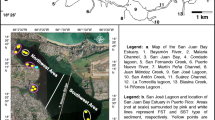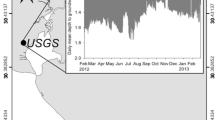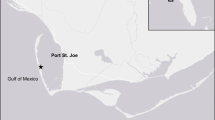Abstract
Nutrient loads from the Mississippi River watershed are associated with seasonal development of bottom-water hypoxia in the northern Gulf of Mexico. Microbial nitrogen (N) transformations at the sediment-water interface are important in determining system productivity and the development and maintenance of hypoxia. Intact sediment cores were incubated in a continuous-flow system with stable isotope tracers to identify and quantify important N sources (e.g., N fixation), sinks (e.g., denitrification and anammox), and links (e.g., dissimilatory nitrate reduction to ammonium, DNRA). Microbial N sinks on the Louisiana-Texas continental shelf remove up to 68 % of the total N load from the Mississippi River watershed, and up to 29 % of this N removal (mean = 11.8 ± 1.7 %) may be due to anammox. The highest N2 production rates and ammonium effluxes were observed at low bottom-water oxygen concentrations, and sediments were a significant source of ammonium to the water column at all times. DNRA and heterotrophic N fixation were not consistent pathways for total sediment N fluxes, but their potential importance to N balance and productivity in the system warrants further study and inclusion in ecosystem models. Physical disturbance from passage of two hurricanes in 2008 resulted in lower N cycling rates and sediment oxygen consumption, with sediment processes migrating into the water column. Denitrification is the dominant N sink in the northern Gulf of Mexico and provides a valuable ecosystem service by mitigating N loads from the Mississippi River watershed, particularly during seasonal bottom-water hypoxia events.






Similar content being viewed by others
References
An, S., and W.S. Gardner. 2002. Dissimilatory nitrate reduction to ammonium (DNRA) as a nitrogen link versus denitrification as a sink in a shallow estuary (Laguna Madre/Baffin Bay, Texas). Marine Ecology Progress Series 237: 41–50.
An, S., T.M. Kana, and W.S. Gardner. 2001. Simultaneous measurement of denitrification and nitrogen fixation using isotope pairing with membrane inlet mass spectrometry analysis. Applied and Environmental Microbiology 67(3): 1171–1178.
Bertics, V.J., J.A. Sohm, T. Treude, C.-E.T. Chow, D.G. Capone, J.A. Fuhrman, and W. Ziebis. 2010. Burrowing deeper into benthic nitrogen cycling: the impact of bioturbation on nitrogen fixation coupled to sulfate reduction. Marine Ecology Progress Series 409: 1–15.
Boesch, D.F., W.R. Boynton, L.B. Crowder, R.J. Diaz, R.W. Howarth, L.D. Mee, S.W. Nixon, N.N. Rabalais, R. Rosenberg, J.G. Sanders, D. Scavia, and R.E. Turner. 2009. Nutrient enrichment drives Gulf of Mexico hypoxia. Eos 90(14): 117–119.
Breitburg, D. 2002. Effects of hypoxia, and the balance between hypoxia and enrichment, on coastal fish and fisheries. Estuaries 25(4B): 767–781.
Brunet, R.C., and L.J. Garcia-Gil. 1996. Sulfide-induced dissimilatory nitrate reduction to ammonia in anaerobic freshwater sediments. FEMS Microbiology Ecology 21: 131–138.
Brunner, C.A., J.M. Beall, S.J. Bentley, and Y. Furukawa. 2006. Hypoxia hotspots in the Mississippi Bight. Journal of Foraminiferal Research 36(2): 95–107.
Burgin, A.J., and S.K. Hamilton. 2007. Have we overemphasized the role of denitrification in aquatic ecosystems? A review of nitrate removal pathways. Frontiers in Ecology and the Environment 5(2): 89–96.
Carini, S.A., M.J. McCarthy, and W.S. Gardner. 2010. An isotope dilution method to measure nitrification rates in the northern Gulf of Mexico and other eutrophic waters. Continental Shelf Research 30: 1795–1801.
Carlucci, A.F., and P.M. McNally. 1969. Nitrification in marine bacteria in low concentrations of substrate and oxygen. Limnology and Oceanography 14(5): 736–739.
Childs, C.R., N.N. Rabalais, R.E. Turner, and L.M. Proctor. 2002. Sediment denitrification in the Gulf of Mexico zone of hypoxia. Marine Ecology Progress Series 240: 285–290 (Erratum 247: 310).
Dagg, M.J., and G.A. Breed. 2003. Biological effects of Mississippi River nitrogen on the northern Gulf of Mexico – a review and synthesis. Journal of Marine Systems 43: 133–152.
Dalsgaard, T., B. Thamdrup, and D.E. Canfield. 2005. Anaerobic ammonium oxidation (anammox) in the marine environment. Research in Microbiology 156: 457–464.
Dekas, A.E., R.S. Poretsky, and V.J. Orphan. 2009. Deep-sea archaea fix and share nitrogen in methane-consuming microbial consortia. Science 326: 422–426.
Delaune, R.D., A. Jugsujinda, I. Devai, and A.X. Hou. 2005. Denitrification in bottom sediment near oil production facilities off the Louisiana Gulf Coast. Chemistry and Ecology 21(2): 101–108.
Dong, L.F., M.N. Sobey, C.J. Smith, I. Rusmana, W. Phillips, A. Stott, A.M. Osborn, and D.B. Nedwell. 2011. Dissimilatory reduction of nitrate to ammonium, not denitrification or anammox, dominates benthic nitrate reduction in tropical estuaries. Limnology and Oceanography 56(1): 279–291.
Eyre, B.D., S. Rysgaard, T. Dalsgaard, and P.B. Christensen. 2002. Comparison of isotope pairing and N2:Ar methods for measuring sediment denitrification – assumptions, modifications, and implications. Estuaries 25: 1077–1087.
Fennel, K., D. Brady, D. DiToro, R.W. Fulweiler, W.S. Gardner, A. Giblin, M.J. McCarthy, A. Rao, S. Seitzinger, M. Thouvenot-Korppoo, and C. Tobias. 2009. Modeling denitrification in aquatic sediments. Biogeochemistry 93(1–2):159–178.
Fogel, M.L., C. Aguilar, R. Cuhel, D.J. Hollander, J.D. Willey, and H.W. Paerl. 1999. Biological and isotopic changes in coastal waters induced by Hurricane Gordon. Limnology and Oceanography 44(6): 1359–1369.
Fulweiler, R.W., S.W. Nixon, B.A. Buckley, and S.L. Granger. 2007. Reversal of the net dinitrogen gas flux in coastal marine sediments. Nature 448: 180–182.
Gardner, W.S., H.A. Bootsma, C. Evans, and P.A. St. John. 1995. Improved chromatographic analysis of 15N:14N ratios in ammonium or nitrate for isotope addition experiments. Marine Chemistry 48: 271–282.
Gardner, W.S., E.E. Briones, E.C. Kaegi, and G.T. Rowe. 1993. Ammonium excretion by benthic invertebrates and sediment-water nitrogen flux in the Gulf of Mexico near the Mississippi River outflow. Estuaries 16(4): 799–808.
Gardner, W.S., and M.J. McCarthy. 2009. Nitrogen dynamics at the sediment-water interface in shallow, sub-tropical Florida Bay: why denitrification efficiency may decrease with increased eutrophication. Biogeochemistry 95: 185–198.
Gardner, W.S., M.J. McCarthy, S. An, D. Sobolev, K.S. Sell, and D. Brock. 2006. Nitrogen fixation and dissimilatory nitrate reduction to ammonium (DNRA) support nitrogen dynamics in Texas estuaries. Limnology and Oceanography 51: 558–568.
Gardner, W.S., M.J. McCarthy, S.A. Carini, A.C. Souza, H. Lijun, K.S. McNeal, M.K. Puckett, and J. Pennington. 2009. Collection of intact sediment cores with overlying water to study nitrogen- and oxygen-dynamics in regions with seasonal hypoxia. Continental Shelf Research 29: 2207–2213.
Gardner, W.S., and S.P. Seitzinger. 1991. The effects of sea salts on the forms of nitrogen released from estuarine and freshwater sediments: does ion pairing affect ammonium flux? Estuaries 14(2): 157–166.
Harned, D.A., J.B. Atkins, and J.S. Harvill. 2004. Nutrient mass balance and trends, Mobile River basin, Alabama, Georgia, and Mississippi. Journal of the American Water Resources Association 40(3): 765–793.
Hou, L., M. Liu, S.A. Carini, and W.S. Gardner. 2012. Transformation and fate of nitrate near the sediment-water interface of Copano Bay. Continental Shelf Research 35: 86–94.
Hou, L., Y. Zheng, M. Liu, J. Gong, X. Zhang, G. Yin, and L. You. 2013. Anaerobic ammonium oxidation (anammox) bacterial diversity, abundance, and activity in marsh sediments of the Yangtze Estuary. Journal of Geophysical Research, Biogeosciences 118: 1237–1246.
Justić, D., and L. Wang. 2013. Assessing temporal and spatial variability of hypoxia over the inner Louisiana-upper Texas shelf: application of an unstructured-grid three-dimensional coupled hydrodynamic-water quality model. Continental Shelf Research 72: 163–179.
Kana, T.M., C. Darkangelo, M.D. Hunt, J.B. Oldham, G.E. Bennett, and J.C. Cornwell. 1994. Membrane inlet mass spectrometer for rapid high-precision determination of N2, O2, and Ar in environmental water samples. Analytical Chemistry 66: 4166–4170.
Kana, T.M., M.B. Sullivan, J.C. Cornwell, and K.M. Groszkowski. 1998. Denitrification in estuarine sediments determined by membrane inlet mass spectrometry. Limnology and Oceanography 43(2): 334–339.
Kana, T.M., and D.L. Weiss. 2004. Comment on “Comparison of isotope pairing and N2:Ar methods for measuring sediment denitrification” by B.D. Eyre, S. Rysgaard, T. Dalsgaard, & P.B. Christensen. 2002. Estuaries 25: 1077–1087. Estuaries 27: 173–176.
Kim, I.-N., and D.-H. Min. 2013. Temporal variation of summertime denitrification rates in the Texas-Louisiana inner shelf region in the Gulf of Mexico: a modeling approach using the extended OMP analysis. Continental Shelf Research 66: 49–57.
Koeve, W., and P. Kähler. 2010. Heterotrophic denitrification vs. autotrophic anammox – quantifying collateral effects on the oceanic carbon cycle. Biogeosciences 7: 2327–2337.
Laursen, A.E., and S.P. Seitzinger. 2002. The role of denitrification in nitrogen removal and carbon mineralization in Mid-Atlantic Bight sediments. Continental Shelf Research 22: 1397–1416.
Lavrentyev, P.J., W.S. Gardner, and L. Yang. 2000. Effects of the zebra mussel on nitrogen dynamics and the microbial community at the sediment-water interface. Aquatic Microbial Ecology 21: 187–194.
Lehrter, J.C., D.L. Beddick Jr., R. Devereux, D.F. Yates, and M.C. Murrell. 2012. Sediment-water fluxes of dissolved inorganic carbon, O2, nutrients, and N2 from the hypoxic region of the Louisiana continental shelf. Biogeochemistry 109: 233–252.
Lin, S., and J.W. Morse. 1991. Sulfate reduction and iron sulfide mineral formation in Gulf of Mexico anoxic sediments. American Journal Sciences 291: 55–89.
Lin, X., M.J. McCarthy, S.A. Carini, and W.S. Gardner. 2011. Net, actual, and potential sediment-water interface NH4 + fluxes in the northern Gulf of Mexico (NGOMEX): evidence for NH4 + limitation of microbial dynamics. Continental Shelf Research 31: 120–128.
McCarthy, M.J., S.A. Carini, Z. Liu, N.E. Ostrom, and W.S. Gardner. 2013. Oxygen consumption in the water column and sediments of the northern Gulf of Mexico hypoxic zone. Estuarine, Coastal and Shelf Science 123: 46–53.
Middelburg, J.J., and L.A. Levin. 2009. Coastal hypoxia and sediment biogeochemistry. Biogeosciences 6: 1273–1293.
Miller-Way, T., G.S. Boland, G.T. Rowe, and R.R. Twilley. 1994. Sediment oxygen consumption and benthic nutrient fluxes on the Louisiana continental shelf: a methodological comparison. Estuaries 17(4): 809–815.
Mulder, A., A.A. van de Graaf, L.A. Robertson, and J.G. Kuenen. 1995. Anaerobic ammonium oxidation discovered in a denitrifying fluidized bed reactor. FEMS Microbiology Ecology 16: 177–184.
Newell, S.E., D. Eveillard, M.J. McCarthy, W.S. Gardner, Z. Liu, and B.B. Ward. 2013. A shift in the archaeal nitrifier community in response to natural and anthropogenic disturbances in the northern Gulf of Mexico. Environmental Microbiology Reports. doi:10.1111/1758-2229.12114.
Nielsen, L.P. 1992. Denitrification in sediment determined from nitrogen isotope pairing. FEMS Microbiology Ecology 86: 357–362.
O’Connor, T., and D. Whitall. 2007. Linking hypoxia to shrimp catch in the northern Gulf of Mexico. Marine Pollution Bulletin 54: 460–463.
Ortiz, D.I.B., F. Thalasso, F. de M.C. López, and A.-C. Texier. 2013. Inhibitory effect of sulfide on the nitrifying respiratory process. Journal of Chemical Technology and Biotechnology 88(7): 344–1349.
Paerl, H.W., J.D. Bales, L.W. Ausley, C.P. Buzzelli, L.B. Crowder, L.A. Eby, J.M. Fear, M. Go, B.L. Peierls, T.L. Richardson, and J.S. Ramus. 2001. Ecosystem impacts of three sequential hurricanes (Dennis, Floyd, and Irene) on the United States’ largest lagoonal estuary, Pamlico Sound, NC. PNAS 98(10): 5655–5660.
Piehler, M.F., & A.R. Smyth. 2011. Habitat-specific distinctions in estuarine denitrification affect both ecosystem function and services. Ecosphere 2(1): 16pp.
Quiñones-Rivera, Z.J., B. Wissel, N.N. Rabalais, and D. Justić. 2010. Effects of biological and physical factors on seasonal oxygen dynamics in a stratified, eutrophic coastal ecosystem. Limnology and Oceanography 55(1): 289–304.
Rabalais, N.N. 2011. Troubled waters of the Gulf of Mexico. Oceanography 24(2): 200–211.
Roberts, K.L., V.M. Eate, B.D. Eyre, D.P. Holland, and P.L.M. Cook. 2012. Hypoxic events stimulate nitrogen recycling in a shallow salt-wedge estuary: The Yarra River estuary, Australia. Limnology and Oceanography 57(5): 1427–1442.
Rowe, G.T., and P. Chapman. 2002. Continental shelf hypoxia: some nagging questions. Gulf of Mexico Science 2002(2): 153–160.
Rowe, G.T., M.E. Cruz Kaegi, J.W. Morse, G.S. Boland, and E.G. Escobar Briones. 2002. Sediment community metabolism associated with continental shelf hypoxia, northern Gulf of Mexico. Estuaries 25(6A): 1097–1106.
Rysgaard, S., R.N. Glud, N. Risgaard-Petersen, and T. Dalsgaard. 2004. Denitrification and anammox activity in Arctic marine sediments. Limnology and Oceanography 49(5): 1493–1502.
Seitzinger, S.P. 1988. Denitrification in freshwater and coastal marine systems: ecological and geochemical significance. Limnology and Oceanography 33(4, Part 2): 702–724.
Sørensen, J., J.M. Tiedje, and R.B. Firestone. 1980. Inhibition by sulfide of nitric and nitrous oxide reduction by denitrifying Pseudomonas fluorescens. Applied and Environmental Microbiology 39(1): 105–108.
Steingruber, S.M., J. Friedrich, R. Gachter, and B. Wehrli. 2001. Measurement of denitrification in sediments with the 15N isotope pairing technique. Applied and Environmental Microbiology 67(9): 3771–3778.
Sun, H., Q. Yang, Y. Peng, H. Shi, S. Wang, and S. Zhang. 2009. Nitrite accumulation during the denitrification process in SBR for the treatment of pre-treated landfill leachate. Chinese Journal of Chemical Engineering 17(6): 1027–1031.
Turner, R.E., and N.N. Rabalais. 1991. Changes in the Mississippi River water quality this century – implications for coastal food webs. Bioscience 41: 140–147.
Turner, R.E., N.N. Rabalias, and D. Justić. 2006. Predicting summer hypoxia in the northern Gulf of Mexico: riverine N, P, and Si loading. Marine Pollution Bulletin 52: 139–148.
Turner, R.E., N.N. Rabalais, D. Justić, and Q. Dortch. 2003. Global patterns of dissolved N, P and Si in large rivers. Biogeochemistry 64: 297–317.
Williams, C.J., J.N. Boyer, and F.J. Jochem. 2008. Indirect hurricane effects on resource availability and microbial communities in a subtropical wetland-estuary transition zone. Estuaries and Coasts 31: 204–214.
Acknowledgments
We thank the captain and crew of the R/V Pelican for assistance with sampling and cruise logistics, Peter Thomas and Ed Buskey for sharing ship time, Afonso Souza, Jiqing Liu, and Lin Xiao for assistance with core and overlying water sampling, Hou Lijun for the PEEK retrofitting, Rae Mooney for the site map, Bess Ward for microarray access and support to SEN, Zhanfei Liu and Nathaniel Ostrom for helpful discussions, Helen Baulch and Roxane Maranger for sharing N2O flux data, and Karen S. McNeal and her students for sharing oxygen and sulfide microelectrode data. We also thank Dubravko Justić and Il-Nam Kim for the surface area estimates of the continental shelf. This work was supported by Grant #NA07NOS4780225 from the National Oceanic and Atmospheric Administration-Center for Sponsored Coastal Ocean Research to WSG, Grant #1240798 from the National Science Foundation-Dimensions in Biodiversity to WSG, and a National Science Foundation Postdoctoral Fellowship to SEN.
Author information
Authors and Affiliations
Corresponding author
Additional information
Communicated by Alf Norkko
Electronic supplementary material
Below is the link to the electronic supplementary material.
Supplementary Fig S1
(DOC 68 kb)
Supplementary Table S1
(DOC 65 kb)
ESM 3
(DOC 35 kb)
Rights and permissions
About this article
Cite this article
McCarthy, M.J., Newell, S.E., Carini, S.A. et al. Denitrification Dominates Sediment Nitrogen Removal and Is Enhanced by Bottom-Water Hypoxia in the Northern Gulf of Mexico. Estuaries and Coasts 38, 2279–2294 (2015). https://doi.org/10.1007/s12237-015-9964-0
Received:
Revised:
Accepted:
Published:
Issue Date:
DOI: https://doi.org/10.1007/s12237-015-9964-0




